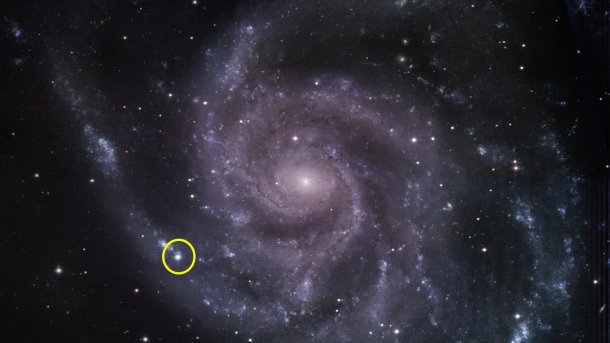Nearest supernova to earth in years yields surprisingly low gamma radiation
The closest supernova to Earth for almost ten years remains a stroke of luck for research. Gamma astronomy, for example, has given it a great puzzle.
SN 2023ixf in the Firewheel Galaxy
(Bild: Hiramatsu et al. 2023/Sebastian Gomez [STScI])
The most sensitive space telescope for gamma-ray astronomy has detected surprisingly little gamma radiation emanating from the closest supernova to Earth in almost 10 years. This poses a puzzle for researchers, explains NASA, which operates the Fermi Gamma-ray Space Telescope. Until now, it had been assumed that around 10 per cent of the energy of such stellar explosions was used to accelerate cosmic rays - which in turn only make themselves felt through gamma rays. In the case of the supernova with the designation SN 2023ixf, however, the measurement data showed that only around one per cent went into this process. This massive deviation must now be explained and thus make a further contribution to the understanding of cosmic radiation.
Searching for the origin of cosmic radiation
As the US space agency explains, the analysis now presented concerns so-called cosmic radiation. This is high-energy particle radiation consisting mainly of protons. Due to their electrical charge, the particles are deflected by magnetic fields as they travel through the universe, meaning that they cannot be traced back to their origin. Their origin is therefore a mystery that is still waiting to be solved more than 100 years after the discovery of cosmic rays. Supernovae, whose shock waves accelerate the particles to such an extent that cosmic rays are produced, have long been at the centre of this search.
When cosmic rays interact with matter, gamma rays are produced, and this is where the Fermi Space Telescope comes into play. It should be able to detect the gamma rays from supernova SN 2023ixf, which are due to this interaction of the cosmic rays produced there. According to Guillem Martí-Devesa from the University of Trieste, who led the analysis, the fact that this was not achieved to the expected extent does not rule out the possibility that such explosions are among the most important sources of cosmic rays, but more needs to be learnt about the production process. At the same time, there are already theories as to why Fermi might have found too little gamma radiation, for example because of the orientation of the exploded star.
SN 2023ixf was discoveredon May 19, 2023 by the Japanese amateur astronomer Koichi Itagaki. The supernova occurred around 21 million light years away. No supernova has been seen at such a close distance - by astronomical standards - for almost ten years. The stellar explosion could initially even be observed using amateur technology. A few days ago, another research group explained that the explosion probably created a black hole. Both studies underline the enormous value of the supernova for research; it and its aftermath will probably be observed for decades to come. The paper on gamma rays is to appear in the journal Astronomy & Astrophysics.
(mho)
